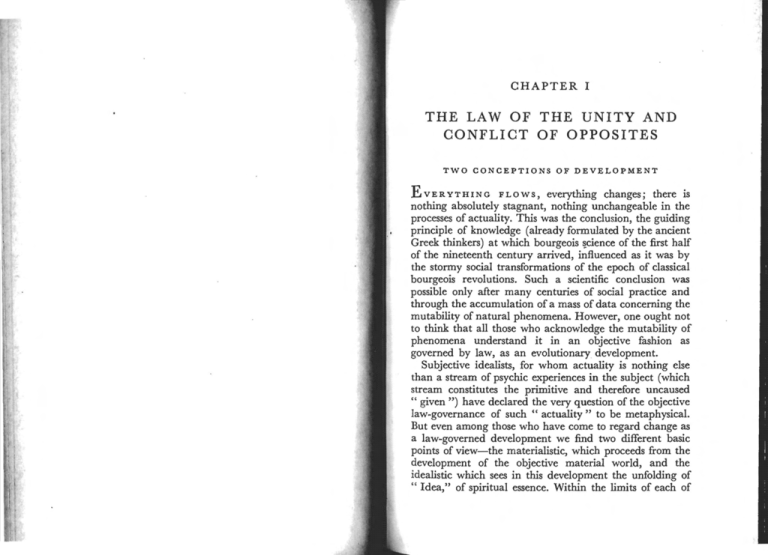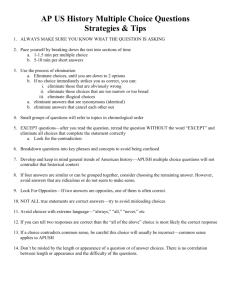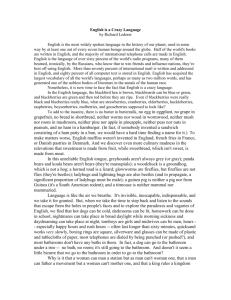the law of the unity and conflict of opposites
advertisement

CHAPTER I THE LAW OF THE UNITY AND CONFLICT OF OPPOSITES TWO CONCEPTIONS OF DEVELOPMENT EVER YTHIN G FLOWS, everything changes; there is nothing absolutely stagnant, nothing unchangeable in the processes of actuality. This was the conclusion, the guiding principle of knowledge (already formulated by the ancient Greek thinkers) at which bourgeois ~cience of the first half of the nineteenth century arrived, influenced as it was by the stormy social transformations of the epoch of classical bourgeois revolutions. Such a scientific conclusion was possible only after many centuries of social practice and through the accumulation of a mass of data concerning the mutability of natural phenomena. However, one ought not to think that all those who acknowledge the mutability of phenomena understand it in an objective fashion as governed by law, as an evolutionary development. Subjective idealists, for whom actuality is nothing else than a stream of psychic experiences in the subject (which stream constitutes the primitive and therefore uncaused " given ") have declared the very question of the objective law-governance of such " actuality" to be metaphysical. But even among those who have come to regard change as a law-governed development we find two different basic points of view-the materialistic, which proceeds from the development of the objective material world, and the idealistic which sees in this development the unfolding of " Idea," of spiritual essence. Within the liInits of each of 134 135 UNITY AND THE STRIFE OF OPPOSITES UNITY AND CONFLICT OF OPPOSITES these basic philosophic camps there exist two more or less clearly expressed conceptions of the type and character of law-governed development; to their survey we shall now proceed. The exponents of the first view see in development a simple increase or diminution, a repetition therefore of that which already exists. Thus qualitatively different physical processes are ascribed by them to different quantitative combinations of atoms or electrons; and transformations of physical processes one into another are ascribed to a quantitative increase, diminution or repetition of those same combinations. In the development of organic life, in the emergence and differentiation of vital forms, they see only a simple quantitative change in that which had already existed in the first living beings that appeared on earth. And so they hold that in the capitalism of the beginning of the twentieth centllry and even in" that of the post-war period there is nothing qualitatively new in comparison with its earlier period of development. In modern capitalism they say we are dealing onry with quantitative developments of already existing elements and factors of capitalism-with a growth of the army of workers, with an increase in the volume of capital investments, with a lessening of the number of owners of means of production. The exponents of this view are really quite unable to offer any solution of the actual problem of developmentthe law-governed emergence of the new out of the old. They merely describe the growth, the decrease, the recurrence of this or that aspect of the object. This first conception remains on the surface of phenomena. It can describe merely the outer appearance of movement but cannot divulge its essence; it is able merely to describe the growth or diminution of different elements. or factors in a process, but cannot explain the internal cause of its evolutionary movement, cannot show how and why a given process develops. The supporters of this conception, when they would attempt such an explanation, are compelled to seek for some external factor to account for the qualitatively new, since this could never be given by merely quantitative changes. It is hardly surprising that they are frequently driven to the theory of divine intervention. The supporters of this view cannot explain how a thing comes to be turned into its own opposite, cannot explain "leaps," the disappearance of the " old" and the emergence of the "new." Thus from this standpoint it is impossible to show why capitalism must inevitably grow into socialism, or why classes in the U.S.S.R. disappear as the result of sharp class struggle. The exponents of this point of view are supporters of the mechanistic conception of development. The exponents of the second conception proceed from the standpoint that everything develops by means of a struggle of opposites, by a division, a dichotomy, of every unity into mutually exclusive opposites. Thus capitalism develops in virtue of the contradiction between the social character of production and the private means of appropriation; transitional economy develops on the basis of the struggle between developing and growing socialism and developed, but not yet annihilated, capitalism, and also on the basis of the sharpened conflict of classes in this period in the course of which classes ultimately disappear. The second conception, not remaining on the surface of phenomena, expresses the essence of movement as the unity of opposites. It demands a penetration into the depth of a process, a disclosure of the internal laws which are responsible for the development of that process. This conception seeks the causes of development not outside the process but in its very midst; it seeks mainly to disclose the source of the "self-movement" of the process. To understand a process means to disclose its contradictory aspects, to establish their mut1lal relationship, to follow up the movement of its contradictions through all its stages. This view gives the key to the "leaps" which characterize the evolutionary series; it explains the changing of a process into its opposite, the annihilation of the 136 137 UNITY AND THE STRIFE OF OPPOSITES UNITY AND CONFLICT OF OPPOSITES " old" and emergence of the " new." Thus only by di~ closing the basic contradictions of capitalism and by show.. ing that the inevitable consequence of such contradictions is the destruction of capitalism by proletarian revolution do we explain the historic necessity of socialism. This second conception is the conception of dialectic materialism. In his celebrated fragment" On Dialectics," Lenin wrote: they act on one another only by collisions resulting from their mechanical movement. The difference between things is explained by the difference in the spatial attributes, the number and mutual arrangement of the aggregates of atoms which compose them. Emergence is the uniting of atoms; disappearance their falling apart. Proceeding from this materialistic conception, the leading one of its time, Leucippus and Democritus explained the origin and development of the solar system, the movement of the human soul, etc. To this point of view, with some variations, Epicurus and his followers adhered. In the seventeenth century a very similar philosophy was established and developed by Pierre Gassendi. His contemporary, the great philosopher and physicist Rene Descartes-idealist on the quest;i,on of the origin of our knowledge, materialist in his physical researches-confirmed the idea of the universal connection of all the phenomena in nature and explained the development of the world purely mechanically, although somewhat differ-. ently from the Greek Atomists. This conception of movement was the basis of most of the physics of that period and finds expression in the works of the great French materialists. The mechanistic attitude was not only dominant in material science but profoundly influenced the theories concerning the development of human society. A succession of bourgeois philosophers explained all social phenomena as due to the simple interactions of individuals seeking their self-preservation. But these philosophers failed to observe the class struggle and the contradictions in society; they were, therefore, quite unable to reveal the actual laws of social development. In more recent times, under the influence of ever intensifying class contradictions, there has appeared a mechanistic theory which sought to explain social development by the antagonism of forces directed one against the other and their eventual equilibrium. The direction of the development of a social phenomenon is, it is said, determined at any particular moment by the quantitative predominance " Two fundamental (or is it the two possible? or is it: the two historically observed?) conceptions of develop.. ment (evolution) are: development as decrease and increase, as repetition; and development as a unity of opposites (the division of the one into mutually exclusive opposites and their reciprocal correlation). "The first conception is dead, poor and dry; the second is vital. It is only this second conception which offers the key to unden;tanding the ' self-movement' of everything in existence; it alone offers the key to understanding' leaps' to the' interruption of gradual succession,' to the ' transformation into the opposite' to the destruction of the old and the appearance of the new." 1 Throughout the whole course of philosophic history we meet with these two conceptions, more or less clearly and precisely formulated, or we meet with views that are occasionally muddled yet approximate to one of these two conceptions of development. Thus the Greek philosophers Leucippus and Democritus attacking the metaphysical theory of the Eleatic school (the school of Parmenides, which held the world to be unchangeable and denied the reality of movement) declared that the world develops according to the principle of necessity; that everything in the world is found in eternal and endless motion. But their conception of development is mechanical. The world, in their opinion, consists of an endless number of atoms, different in form and moving in empty space. In the atoms there exist no internal states; 1 Lenin, vol. xiii, p. 323. 138 UNITY AND THE STRIFE OF OPPOSITES of the force which determines that direction. Thus, according to Herbert Spencer, "tyranny. and ~eedom" are forces independent of each other, which stnve to balance each other. By the quantitative predominance of freedom· or of tyranny the resultant of this antagonism is determined. We also find this prillciple of development in Diihring, who attacked the dialectic of Marx and Engels, and after Diihring came Bogdanov who constructed a complete philosophy which proposed to explain ev~ry. phenomen~~ of nature, society and thought by the pnnclple of equilibrium. This conception was afterwards borrowed from Bogdanov by Bukharin who saw the cause of the development of. social structures not in their internal contradictions but in the relationship of the system with the environment, of. society with nature. The mechanistic theory of development permeates reformist sociology, which holds that the simple quantitative growth of monopoly and of finance-capital signifies the growing of capitalism into ~ocialism, that the ~imple growth of bourgeois democracy 15 an ever greater wmmng of power by the working class, etc. These philosophers have thrown aside the theory of movement by means of contradictions as too revolutionary. A mechanistic principle of development also penetrates the view~ of !rotskyism' for instance its acceptance of the superfiClal Vlew tha capitalism was planted in Russia by the West, a view which ignores the development of capitalism that proceeded among us on the basis of the break-up of the peasant com . munity. The Trotskyist theory of the impossibility of. socialist victory in one country alone proceeds from 1 ignoring of the unevenness of the development of capital ism and of the internal laws of development of th U.S.S.R. which have by the operation of new intern forces made it possible to resolve those contradictions ofth proletariat and peasantry that obstruct the building. socialism. This theory holds that the external contra tions of capitalism and the U.S.S.R. are the dete .• UNITY AND CONFLICT OF OPPOSITES 139 factor in our development, and that the course of development of the environment (capitalism) determines the course of development of the system, i.e. the U.S.S.R. . Not only the mechanistic but also the dialectical conception of development is met in the course of philosophic history. "Movement itself is a contradiction," the Eleatics pointed out, and that is the very reason why they, as metaphysicians, denied the objectivity of movement. The greatest of them, Zeno, brought together a number of examples to refute the objectivity of movement. The basis of his proof is that movement contains within itself a contradiction and is therefore untrue, since from the viewpoint of the Eleatics a thing is true only if it is at one with itself, is identical with itself, unalterable. The Greek philosopher Heraclitus declared: "Ail things flow, all changes. It is impossible to enter twice into one and the same stream." Everything is found in eternal flux, at one moment in the process of stabilization, in the next of passing away. He affirmed that everything is found in development by virtue of the strife of opposites. In the new philosophy which grew up along with the rise of the bourgeoisie the idea of development by means of contradiction was revived by Kant and Hegel. In opposition to the view of Newton, who held that the movement of the solar system, once it had been brought into existence as a result of the first divine impulse, remains unchanged, and that the planets preserve their primeval relative distances and distribution, Kant, in the early phase of his development, propounded a theory of the origin of the solar system from a revolvmg nebula without the intervention of God. He affirmed that out of the primeval nebula, as a result of the struggle arising from the repulsion and attraction of its components, was formed a system of planets, including our earth, and he predicted an inevitable collapse of that system in the distant future. Kant's notion of development still lay as a whole within the bounds of a mechanistic world-outlook, for we see that attraction and repulsion were considered by him as 140 UNITY AND THE STRIFE OF OPPOSITES opposing mechanical forces belonging t? matt~r. It was only later in his more fundamental phil.osop~lcal works that the critical Kant approached to a dialectlcal ,:n~er­ standing of contradiction, which, howeve.r, he now limlt~ by the bounds of reason, ruling out any Idea of contradiction in connection with the objective world of " things in themselves." The idealist system which most clearly and fully -:vorks out the idea of development by means of the strife of opposites was that of Hegel, and this part of his philosophy is his greatest contribution to human thought. He wrote: " Identity is the definition only of a simple, immediate, dead being, but contradiction is the root ?f all mo:,e~en~ and vitality, and only in so far as a thing has ~n ltse contradiction does it move, does it possess an lffipulse and activity. "Contradiction is not simply the negation of nor... mality but is the principle of every self-movement, ?f tha~ which indeed is nothing else than the expreSSIOn 0 contradictions. "All things are contradictory in themselves--: • proposition expresses the truth and essence of thm better than any other." Hegel, in opposition to Kant, held that it is imJ;>O~ibl to attribute contradiction to the subject alone. He mSlst. on the necessity of disclosing the contradictions i? t~e v • process of actuality (which was understood by him Idea tically) because in the strife of opposites he saw the roo the basis of every self-movement. But having set up this basic law of development, idealist Hegel inevitably distorted and limited it. He he that the movement of the objective world is a form movement of absolute spirit, and subordinated the deve! ment of objective processes to a system of categories, m up in his own head. Thus a~every step he ~e~raYe? the la: he had himself set up. Bemg a bourgeoIS Idealist and UNITY AND CONFLICT OF OPPOSITES 141 German philistine he declared that in the Idea, i.e. in the highest stage of development, contradictions are reconciled, a stoppage of development takes place. Mter depicting the movement of society as the development of the World Spirit through contradictions, he declared that in the Prussian monarchy:"""':the highest incarnation of the State idea-social contradictions were reconciled. Thus Hegel subordinated the revolutionary law of a struggle of opposites to the. bourgeois theory of their reconc!liation. Modern neo-Hegelians like Bradley, and Gentile, the philosopher of Fascism, act as did the reactionaries of Hegel's day; they seize on this reactionary side of. t.he Hegelian philosophy and develop a theory of reconClliation of opposites. Marx and Engels, on the contrary, took from Hegel this same revolutionary side, reworkec;l it critically and developed the law of the unity and conflict of opposites. Lenin wrote: " Consider such expressions as 'movement and selfmovement,' meaning spontaneous, internally necessary movement, 'change,' 'movement and vitality,' 'the principle of every self-movement,' 'movement a~d action' in contrast to 'dead existence '-and who wIll believ~ that these represent the very core of Hegel's frozen absolutism, as it has been called. It is necessary to disclose this essence, to understand it, to save it, to remove its shell, to cleanse it-and that is what Marx and Engels did." . Marxand Engels, being materialist-communists and therefore free from the half-and-half policy of Hegel, were the first to show the essentially revolutionary character of this law. In a large number of their works-Capital, Anti-Diihring, The Pouerty ofPhilosophy, Ludwig Feuerbach, Dialectic of Nature -as well as in a number of their letters, they indicated the theoretical and practical importance of this law as a universal law of the development of nature, society and 142 143 UNITY AND THE STRIFE OF OPPOSITES UNITY AND CONFLICT OF OPPOSITES thought. They were the first logically, dispassionately and exhaustively to apply it to the analysis of all those processes. and phenomena which they undertook to investigate, whether it was the analysis of the basic laws of development of social structures, the analysis of capitalism, the different historic episodes of class struggle, the politics and tactics of the workers' movement, or the development of technique and natural science. They did not constrict the investigation of concrete processes by forcing it to conform with ready-made abstract schemes, they did not subordinate it to an artificial, laboured movement of categories, as did Proudhonand Lassalle, who succumbed to the worst features of Hegelianism, but they disclosed the internal contradiction of processes and traced out their movement and mutual connection, their transitions one to another in all their concrete and unique characteristics. In their enquiries Marx and Engels did not confine themselves to pointing to the presence of all the contradictions in this or that process as though they were of equal impo tance, but singled out the essential contradiction upo which the others depended. Marx applied this law of th . unity and conflict of opposites with remarkable complet ness and thoroughness in his Capital, which remains till . day the unsurpassed model of the application of dialecti materialism to the investigation of the complex process social development. Marx showed in Capital the movem of the contradictions of capitalism from its rise to its deca and established the necessity ofits final downfall. He show how the contradictions of capitalism are intensified a how all the conditions and possibility of their revolution solution are being prepared. He was able to show just h it was possible to prepare practically for the solution those contradictions which are the motive force of s . development. Thus he became the founder of the strat and tactics of the workers' party. His analysis showed wf great force that the unity of capitalism was relative that the struggle of opposites within it was absolut fundamental. In contrast to the reformist theoreticians who discarded Marxian dialectic as an "unnecessary survival," Lenin remained faithful to it, made it concrete, developed and exalted it to a higher level. His service in working out and further developing the law of opposites was very great. In the struggle with the liberals, the reformists, the Social Revolutionary Partyl an,d dissentients within the party, he applied it in just as masterly a fashion as Marx to the investigation of whatever phenomena he chose to consider. He investigated the further development of the contradictions of capitalism in the epoch of imperialism, he uncovered the basic contradictions and transitions of the contradictory forces· at different stages of the class struggle and brilliantly applied this basic law of dialectic to the policy and tactics of the party. In his struggle with the Kantians, with the Machists, with bourgeois reactionary philosophy he showed in masterly manner the bi-polar nature of thought, the fact that it is at one and the same time relative and absolute. By developing Marxism both on the basis of the experience of the class struggle in the epoch of imperialism (from which he drew important conclusions) and on the basis of new developments in science since the time of Engels, he gave a most brilliant philosophic expression to the law of opposites as the basic law of development. To sum up, the two fundamental conceptions of development are the mechanistic, which regards development as a simple increase, diminution and repetition, and the dialectic, which sees in development the division of a unitary process, the unity and conflict of opposites. In the same year, 1914, that Lenin was writing his notes " On Dialectic," J. V. Plekhanov in his work From Idealism to Materialism sought to formulate his own understanding of the two conceptions of development. He ~rote : " Hegel's view-point was the view-point of development. But one can understand development in different 1 Social RevolutioTUJry. This party desired an agrarian revolution to the advantage of the peasants who were their chief support. They were extreme petty bourgeois democrats and often resorted to terrorism. 144 UNITY AND THE STRIFE OF OPPOSITES ways. Even nowadays we still meet naturalists who repeat sententiously, ' Nature does not make leaps.' Sociologists too quite often repeat the same thing, ' Social development is accomplished by means ofslow, gradual changes.' Hegel affirmed, on the contrary, that just as in nature so too in history leaps are unavoidable. ' Changes of being,' he says, , consist not only in the transition of one quantity to another quantity, but also in the transition of quality into quantity, and the reverse process-every one of the transitions of the latter type forms a break in gradualness and gives to the phenomenon an entirely new character, qualitatively different from the former.' Development becomes comprehensible only when we consider gradual changes as a process by which a leap (or leaps maybe) is prepared and evoked. Whoever wishes to explain the emergence of a given phenomenon merely by slow changes must in fact unconsciously suppose that it has already existed but remained unnoticed because its dimeTlSions are too minute. But in such an ' explanation' the notion of emergence is replaced by the notion of growth, of a simple change of magnitude, Le. the very thing requiring explanation is arbitrarily removed." Plekhanov has correctly formulated the essence of the mechanistic conception of development, but he did not succeed in showing the dialectical essence. He speaks of leaps, of the breaking of continuity, of the transition of quantity into quality. But he has not seized the main point, the essential thing in the conception of development. He has not understood the duality which is found within the unity, in other words the unity and conflict of opposites, that fundamental conception which alone gives us the key to the understanding of leaps in evolution, of breaks in gradualness, of the transition of quantity into quality, in fact, of the whole developmental process in nature and history. I 1 1 I








